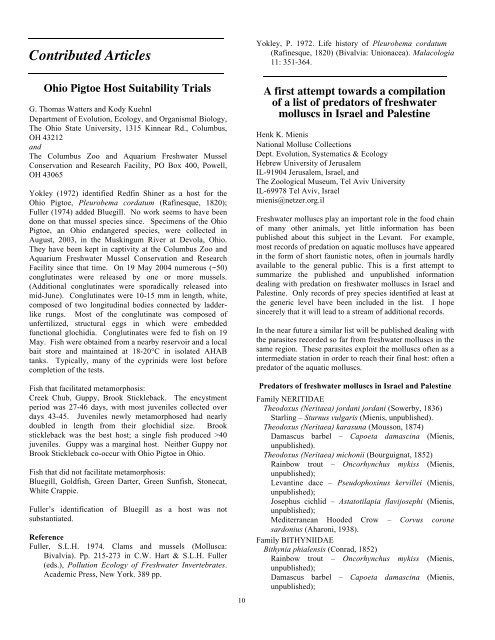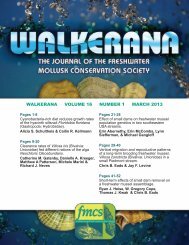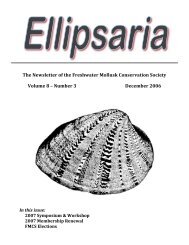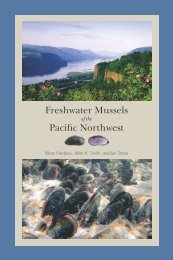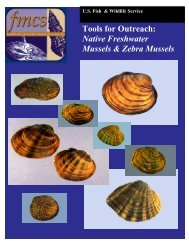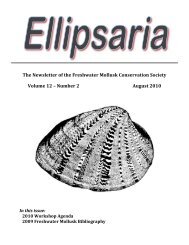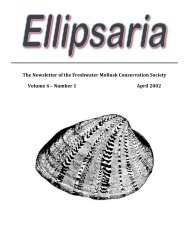August 2004 - FMCS-Freshwater Mollusk Conservation
August 2004 - FMCS-Freshwater Mollusk Conservation
August 2004 - FMCS-Freshwater Mollusk Conservation
You also want an ePaper? Increase the reach of your titles
YUMPU automatically turns print PDFs into web optimized ePapers that Google loves.
Contributed Articles<br />
Ohio Pigtoe Host Suitability Trials<br />
G. Thomas Watters and Kody Kuehnl<br />
Department of Evolution, Ecology, and Organismal Biology,<br />
The Ohio State University, 1315 Kinnear Rd., Columbus,<br />
OH 43212<br />
and<br />
The Columbus Zoo and Aquarium <strong>Freshwater</strong> Mussel<br />
<strong>Conservation</strong> and Research Facility, PO Box 400, Powell,<br />
OH 43065<br />
Yokley (1972) identified Redfin Shiner as a host for the<br />
Ohio Pigtoe, Pleurobema cordatum (Rafinesque, 1820);<br />
Fuller (1974) added Bluegill. No work seems to have been<br />
done on that mussel species since. Specimens of the Ohio<br />
Pigtoe, an Ohio endangered species, were collected in<br />
<strong>August</strong>, 2003, in the Muskingum River at Devola, Ohio.<br />
They have been kept in captivity at the Columbus Zoo and<br />
Aquarium <strong>Freshwater</strong> Mussel <strong>Conservation</strong> and Research<br />
Facility since that time. On 19 May <strong>2004</strong> numerous (~50)<br />
conglutinates were released by one or more mussels.<br />
(Additional conglutinates were sporadically released into<br />
mid-June). Conglutinates were 10-15 mm in length, white,<br />
composed of two longitudinal bodies connected by ladderlike<br />
rungs. Most of the conglutinate was composed of<br />
unfertilized, structural eggs in which were embedded<br />
functional glochidia. Conglutinates were fed to fish on 19<br />
May. Fish were obtained from a nearby reservoir and a local<br />
bait store and maintained at 18-20°C in isolated AHAB<br />
tanks. Typically, many of the cyprinids were lost before<br />
completion of the tests.<br />
Fish that facilitated metamorphosis:<br />
Creek Chub, Guppy, Brook Stickleback. The encystment<br />
period was 27-46 days, with most juveniles collected over<br />
days 43-45. Juveniles newly metamorphosed had nearly<br />
doubled in length from their glochidial size. Brook<br />
stickleback was the best host; a single fish produced >40<br />
juveniles. Guppy was a marginal host. Neither Guppy nor<br />
Brook Stickleback co-occur with Ohio Pigtoe in Ohio.<br />
Fish that did not facilitate metamorphosis:<br />
Bluegill, Goldfish, Green Darter, Green Sunfish, Stonecat,<br />
White Crappie.<br />
Fuller’s identification of Bluegill as a host was not<br />
substantiated.<br />
Reference<br />
Fuller, S.L.H. 1974. Clams and mussels (Mollusca:<br />
Bivalvia). Pp. 215-273 in C.W. Hart & S.L.H. Fuller<br />
(eds.), Pollution Ecology of <strong>Freshwater</strong> Invertebrates.<br />
Academic Press, New York. 389 pp.<br />
10<br />
Yokley, P. 1972. Life history of Pleurobema cordatum<br />
(Rafinesque, 1820) (Bivalvia: Unionacea). Malacologia<br />
11: 351-364.<br />
A first attempt towards a compilation<br />
of a list of predators of freshwater<br />
molluscs in Israel and Palestine<br />
Henk K. Mienis<br />
National Mollusc Collections<br />
Dept. Evolution, Systematics & Ecology<br />
Hebrew University of Jerusalem<br />
IL-91904 Jerusalem, Israel, and<br />
The Zoological Museum, Tel Aviv University<br />
IL-69978 Tel Aviv, Israel<br />
mienis@netzer.org.il<br />
<strong>Freshwater</strong> molluscs play an important role in the food chain<br />
of many other animals, yet little information has been<br />
published about this subject in the Levant. For example,<br />
most records of predation on aquatic molluscs have appeared<br />
in the form of short faunistic notes, often in journals hardly<br />
available to the general public. This is a first attempt to<br />
summarize the published and unpublished information<br />
dealing with predation on freshwater molluscs in Israel and<br />
Palestine. Only records of prey species identified at least at<br />
the generic level have been included in the list. I hope<br />
sincerely that it will lead to a stream of additional records.<br />
In the near future a similar list will be published dealing with<br />
the parasites recorded so far from freshwater molluscs in the<br />
same region. These parasites exploit the molluscs often as a<br />
intermediate station in order to reach their final host: often a<br />
predator of the aquatic molluscs.<br />
Predators of freshwater molluscs in Israel and Palestine<br />
Family NERITIDAE<br />
Theodoxus (Neritaea) jordani jordani (Sowerby, 1836)<br />
Starling – Sturnus vulgaris (Mienis, unpublished).<br />
Theodoxus (Neritaea) karasuna (Mousson, 1874)<br />
Damascus barbel – Capoeta damascina (Mienis,<br />
unpublished).<br />
Theodoxus (Neritaea) michonii (Bourguignat, 1852)<br />
Rainbow trout – Oncorhynchus mykiss (Mienis,<br />
unpublished);<br />
Levantine dace – Pseudophoxinus kervillei (Mienis,<br />
unpublished);<br />
Josephus cichlid – Astatotilapia flavijosephi (Mienis,<br />
unpublished);<br />
Mediterranean Hooded Crow – Corvus corone<br />
sardonius (Aharoni, 1938).<br />
Family BITHYNIIDAE<br />
Bithynia phialensis (Conrad, 1852)<br />
Rainbow trout – Oncorhynchus mykiss (Mienis,<br />
unpublished);<br />
Damascus barbel – Capoeta damascina (Mienis,<br />
unpublished);


